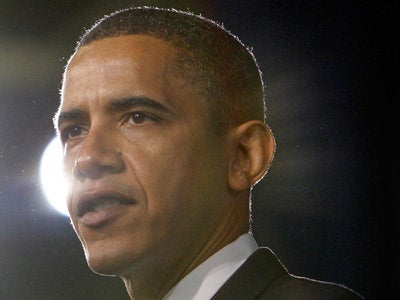
For the first time in history, Americans elected a former community organizer as their President. Barack Obama is going to need all those organizing skills to be an effective leader. To achieve a progressive agenda, Obama will have to win over some reluctant Democrats and a few moderate Republicans. Like Franklin Roosevelt and Ronald Reagan, Obama can use his bully pulpit to inspire and educate Americans to help move the country in a new direction. But like those two transformational presidents, Obama will also need to get the ground troops mobilized, in key states and Congressional districts, to put pressure on members who might otherwise sit on the fence.
Obama can learn valuable lessons from FDR, who recognized that his ability to push New Deal legislation through Congress depended on the pressure generated by protestors and organizers. He once told a group of activists who sought his support for legislation, "You've convinced me. Now go out and make me do it."
As Depression conditions worsened, and as grassroots worker and community protests escalated throughout the country, Roosevelt became more vocal, using his bully pulpit--in speeches and radio addresses--to promote New Deal ideas. Labor and community organizers felt confident in proclaiming, "FDR wants you to join the union." With Roosevelt setting the tone, and with allies in Congress, grassroots activists won legislation guaranteeing workers' right to organize, the minimum wage, family assistance for mothers, Social Security, banking reform, and the 40-hour week.
Some pundits are already trying to diminish Obama's accomplishment. They have attributed Obama's victory to the troubled economy, Bush's unpopularity, or to the Illinois Senator's personal charisma. All these factors mattered, but the real key to Obama's success was grassroots organizing.
The Obama campaign hired hundreds of organizers from labor unions, community and environmental organizations, and religious groups. They, in turn, recruited tens of thousands of volunteers and trained them in the skills of community organizing. They used doorknocking, small house meetings, cell phones, and the Internet to motivate and energize supporters. They used the Internet and social networks to raise funds, in small and large amounts, from the largest-ever donor base. They opened more local offices than any other presidential campaign, including outposts in small towns and suburbs in traditionally Republican areas.
Many organizations and constituencies, outside the official campaign, had a hand in Obama's win. Groups as diverse as MoveOn.Org, labor unions, community groups like ACORN, environmental and consumer organizations like the Sierra Club and US Action, civil rights and women's groups, student activists, and many others can claim a part not only of Obama's triumph but also the dramatic increase in Democratic victories in the House and Senate by educating and mobilizing voters .
These organizing efforts account for the unprecedented increase in voter registration and voter turnout, especially among first-time voters, young people, African Americans, Hispanics, and union members.
Now Obama's supporters will need to transform that electoral energy into a grassroots movement for change. Political campaigns frequently promise to sustain the momentum after election day, but they rarely do. (The late Senator Paul Wellstone, who built a strong progressive coalition in Minnesota, was a notable exception). The lists of volunteers, email addresses, donors, and other key ingredients get lost or put on the shelf until the next election, when the campaign almost starts from scratch.
But from the outset, the Obama campaign recognized that winning the election on November 4 was only the first stage of a broader crusade to help America live up to its potential. So now comes the really hard part. Can Obama's supporters transform the electoral campaign into a grassroots movement? Can they turn campaign volunteers into ongoing community activists? Can they keep many of those organizers employed to sustain and expand the political base that catapulted Obama and Congressional Democrats into office? Can they keep the fragmented mosaic of issue-oriented activists from breaking off into their separate silos, each pursuing their own agendas? Can they agree on a small number of top policy priorities -- for the first year, the first term, and the second term -- and wage effective campaigns to achieve legislative victories? Can they take advantage of the key progressive think tanks, such as the Center for American Progress, the Economic Policy Institute, the Center on Budget & Policy Priorities, and others, to generate accessible policy ideas that reporters, columnists, and activists can use to help promote the Democratic agenda?
The success of the conservative movement, starting in the late 1970s, was due in large measure to the self-discipline of its varied parts -- right-wing foundations, think tanks, radio and TV talk shows, magazines and websites, corporate funders, grassroots groups like the NRA and the Christian Coalition, and Republican Party officials and activists -- to stifle their differences and coordinate their stategies and tactics. Political operatives like Grover Norquist -- who runs Americans for Tax Reform but who is really the conservative movement's chief organizer -- kept the right-wing machine well-oiled. But the Bush Administration was too incompetent to sustain that brittle coalition. The 2008 election revealed the cracks within the GOP coalition, especially between economic conservatives within Big Business and the social conservatives of the Religious Right and the NRA.
In 1992, the last time Americans elected a Democratic president, many Americans hoped that Bill Clinton's victory would usher in a new era economic and social reform. But Clinton, who received only 43% of the overall vote -- with 38% for George H.W. Bush and 19% for Ross Perot -- was elected without a ma jority mandate. Equally important, his own party, while capturing a majority of the seats in Congress, was deeply divided, with many members closely linked to big business interests who opposed progressive taxation, Keynesian pump-priming, and social spending.
Not suprisingly, Congress quickly rejected Clinton's economic stimulus and jobs plan, which included a large public works initiative, which some of his own middle-of-the-road advisors viewed as a budget-buster rather than as an investment in rebuilding the economy. They also rejected his health care reform proposal, due in large measure to the intensive lobbying and public relations campaign launched by the insurance and pharmaceutical industries.
The problem was compounded by the Clintonites failure to unify and mobilize their political base around a legislative agenda. Instead, progressives and liberals fragmented into different camps over the economic stimulus plan and health care reform.
The current situation is both similar and different. Obama earned a healthy majority (52.4%) of the popular vote. The Democrats expanded their margins in both the Senate and the House, capturing several longstanding "red" seats. Depending on the outcome of several tight races (in Georgia, Minnesota, and Alaska), they now have at least 57 seats in the Senate (if we include the two independents, Bernie Sanders and Joe Leiberman).
But several of them are moderate, corporate-friendly Democrats, like Mary Landreiu of Louisiana and Max Baucus of Montana as well as some newcomers. They will be, at best, reluctant reformers. That gives the handful of moderate Republicans in the Senate -- especially Pennsylvania's Arlen Spector, Maine's Olympia Snowe and Susan Collins -- enormous influence. Activists, as well as House Speaker Nancy Pelosi and Senate Majority Leader Harry Reid, will need to focus attention on these moderate Dems and Republicans to support a progressive agenda.
Although some conservative and mainstream pundits are already claiming that despite Obama's victory, America is basically a "center right" nation, public opinion polls reveal that a significant majority of Americans want a more activist government around economic, environmental and consumer issues.
Obama understands that it won't be easy to enact a economic stimulus package than includes infrastructure projects and green jobs, reform health care, pull U.S. troops from Iraq, strengthen labor laws, tackle global warming, help homeowners avoid foreclosure and strengthen bank regulations, and adopt a progressive tax plan. The energy industry, the pharmaceutical and insurance lobbies, the big defense contractors, and others will be working overtime to thwart Obama's progressive policy agenda.
"Nothing in this country worthwhile has ever happened except when somebody somewhere was willing to hope," Obama said during the campaign. Change comes about by "imagining, and then fighting for, and then working for, what did not seem possible before."
As Obama assembles his "inside" White House team and his Cabinet and sub-Cabinet appointments, he will need to pay equal attention to the "outside" efforts of activists, think tanks, and others who he'll need to build support for his agenda.
Obama has clearly touched a nerve in America's body politic. Americans are hungry for hope and ready for reform. But it will require Obama to use all his rhetorical, organizing and political skills to shape public opinion, encourage Americans to mobilize, and re-invent the spirit and momentum of his campaign into a grassroots movement to move the country in a new direction.
Peter Dreier is the E.P. Clapp Distinguished Professor of Politics at Occidental College
